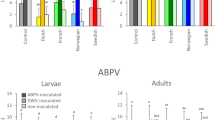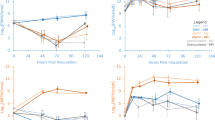Abstract
Non-infested, young adult honey bees (Apis mellifera L.) of two stocks were exposed to tracheal mites (Acarapis woodi (Rennie)) in infested colonies to determine how divergent levels of susceptibility in host bees differentially affect components of the mite life history. Test bees were retrieved after exposure and dissected to determine whether resistance is founded on the reduced success of gravid female (foundress) mites to enter the host tracheae, on the suppressed reproduction by foundress mites once established in host tracheae or on both. Cohorts of 30–60 bees from each of ten resistant colonies and eight susceptible colonies were tested in eight trials (three to five colonies per stock per trial) having exposure durations of 4, 9 or 21 days. The principal results were that lower percentages of resistant bees than of susceptible bees routinely became infested by foundress mites, individual infested susceptible bees often had more foundress mites than individual infested resistant bees did and mite fecundity was similar in both host types. The infestation percentage results corresponded well with similar results from a prior field test of these stocks and, thus, suggest that the bioassay is useful for assessing honey bee resistance to A. woodi.
Similar content being viewed by others
References
Bailey, L. and Ball, B.V. 1991. Honey Bee Pathology, 2nd edn. Academic Press, London.
Clark, K.J., Huxter, E., Gates, N.J. and Szabo, T.I. 1990. Screening breeder honey bee stock for resistance to tracheal mites. Am. Bee J. 130: 800.
Cochran, W.G. and Cox, G.M. 1957. Experimental Designs, 2nd edn. John Wiley and Sons, New York.
Danka, R.G., Villa, J.D., Rinderer, T.E. and Delatte, G.T. 1995. Field test of resistance to Acarapis woodi (Acari: Tarsonemidae) infestation and of colony production by four stocks of honey bees (Hymenoptera: Apidae). J. Econ. Entomol. 88: 584–591.
de Guzman, L.I. 1994. Tolerance potential and defense mechanisms of honey bees (Apis mellifera L.) to Varroa jacobsoni Oud. (Acari: Varroidae) and Acarapis species (Acari: Tarsonemidae). PhD dissertation, Louisiana State University, USA.
Eischen, F.A., Cardoso-Tamez, D., Wilson, W.T. and Dietz, A. 1989. Honey production of honey bee colonies infested with Acarapis woodi (Rennie). Apidologie 20: 1–8.
Furgala, B., Duff, S., Aboulfaraj, S., Ragsdale, D. and Hyser, R. 1989. Some effects of the honey bee tracheal mite (Acarapis woodi Rennie) on non-migratory, wintering honey bee (Apis mellifera L.) colonies in east central Minnesota. Am. Bee J. 129: 195–197.
Gary, N.E. and Page, R.E.Jr 1987. Phenotypic variation in susceptibility of honey bees, Apis mellifera, to infestation by tracheal mites, Acarapis woodi. Exp. Appl. Acarol. 3: 291–305.
Gary, N.E., Page, R.E.Jr and Lorenzen, K. 1989. Effect of age of worker honey bees (Apis mellifera) on tracheal mite (Acarapis woodi) infestation. Exp. Appl. Acarol. 7: 153–160.
Lin, H., Otis, G.W. and Scott-Dupree, C. 1996. Comparative resistance in Buckfast and Canadian stocks of honey bees (Apis mellifera L.) to infestation by honey bee tracheal mites (Acarapis woodi (Rennie)). Exp. Appl. Acarol. 20: 87–101.
Margolis, L., Esch, G.W., Holmes, J.C., Kuris, A.M. and Schad, G.A. 1982. The use of ecological terms in parasitology (Report of an ad hoc committee of the American Society of Parasitologists). J. Parasitol. 68: 131–133.
Milne, C.P., Otis, G.W., Eischen, F.A. and Dormaier, J.M. 1991. A comparison of tracheal mite resistance in two commercially available stocks of honey bees. Am. Bee J. 131: 713–718.
Otis, G.W. and Scott-Dupree, C.D. 1992. Effects of Acarapis woodi on overwintered colonies of honey bees (Hymenoptera: Apidae) in New York. J. Econ. Entomol. 85: 40–46.
Page, R.E.Jr and Gary, N.E. 1990. Genotypic variation in susceptibility of honey bees (Apis mellifera) to infestation by tracheal mites (Acarapis woodi). Exp. Appl. Aracol. 8: 275–283.
Pettis, J.S. and Wilson, W.T. 1996. Life history of the honey bee tracheal mite (Acari: Tarsonemidae). Ann. Entomol. Soc. Am. in press.
Pettis, J.S., Wilson, W.T. and Eischen, F.A. 1992. Nocturnal dispersal by female Acarapis woodi in honey bee (Apis mellifera) colonies. Exp. Appl. Acarol. 15: 99–108.
Phelan, P.L., Smith, A.W and Needham, G.R. 1991. Mediation of host selection by cuticular hydrocarbons in the honeybee tracheal mite Acarapis woodi (Rennie). J. Chem. Ecol. 17: 463–473.
SAS Institute. 1989. SAS/STAT User's Guide, Version 6, 4th edn. Vol. 2. SAS Institute, Cary, NC.
Szabo, T.I., Lefkovitch, L.P. and Clark, K.J. 1991. Comparative resistance of honey bees from a closed population to infestation by tracheal mites. Am. Bee J. 131: 643–645.
Author information
Authors and Affiliations
Rights and permissions
About this article
Cite this article
Danka, R.G., Villa, J.D. Influence of resistant honey bee hosts on the life history of the parasite Acarapis woodi . Exp Appl Acarol 20, 313–322 (1996). https://doi.org/10.1007/BF00052961
Issue Date:
DOI: https://doi.org/10.1007/BF00052961




